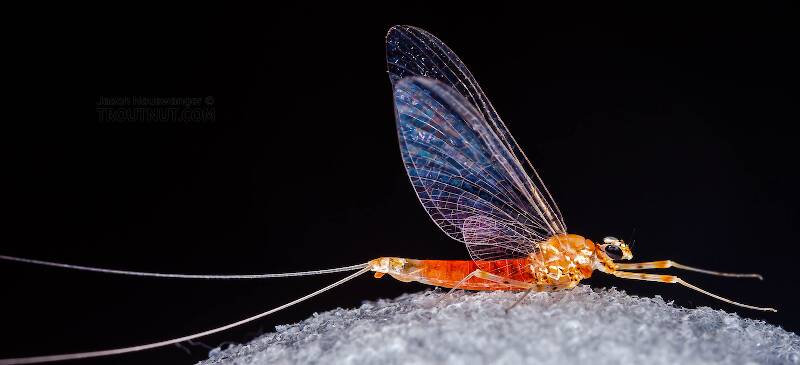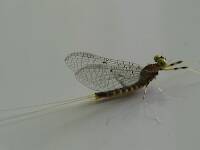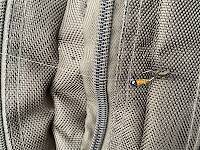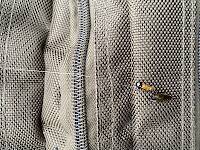
Blue-winged Olives
Baetis
Tiny Baetis mayflies are perhaps the most commonly encountered and imitated by anglers on all American trout streams due to their great abundance, widespread distribution, and trout-friendly emergence habits.
Featured on the forum

I was not fishing, but happened to be at an unrelated social event on a hill above this tiny creek (which I never even saw) when this stonefly flew by me. I assume it came from there. Some key characteristics are tricky to follow, but process of elimination ultimately led me to Sweltsa borealis. It is reassuringly similar to this specimen posted by Bob Newell years ago. It is also so strikingly similar to this nymph from the same river system that I'm comfortable identifying that nymph from this adult. I was especially pleased with the closeup photo of four mites parasitizing this one.

Troutnut is a project started in 2003 by salmonid ecologist Jason "Troutnut" Neuswanger to help anglers and
fly tyers unabashedly embrace the entomological side of the sport. Learn more about Troutnut or
support the project for an enhanced experience here.
Troutnut on Oct 4, 2006October 4th, 2006, 1:03 pm EDT
Most of this relatively large spinner's features make me think Maccaffertium but the fore tarsal ratio and the upward slant of the basal costal crossveins seem to fit Epeorus. Any thoughts? I'm guessing it's a late-season vitreus.
Jason Neuswanger, Ph.D.
Troutnut and salmonid ecologist
Troutnut and salmonid ecologist
GONZO on Oct 5, 2006October 5th, 2006, 8:51 am EDT
I'll second your call on this one. Some female "salmon spinners" of Stenacron look similar to this at first, but the dark crossveins usually give them away upon closer inspection.
Most of the female vitreus spinners I've seen have tails that are darker basally, but I don't think that's any reason to question the identity of this specimen. As far as I know, the only other Epeorus spinner with this coloration is albertae, and I think we can probably rule that out based on distribution.
Most of the female vitreus spinners I've seen have tails that are darker basally, but I don't think that's any reason to question the identity of this specimen. As far as I know, the only other Epeorus spinner with this coloration is albertae, and I think we can probably rule that out based on distribution.
GONZO on Oct 5, 2006October 5th, 2006, 7:05 pm EDT
I was just flipping through some of my collecting notes while lounging in front of some late-night TV. One is from Aug. 8, 2003 on the Yellow Breeches, and I'll quote it verbatim:
"female spinner, 12mm, orange tergites w/ brown marks, orange head w/ pale green eyes, two tan tails, tan rear legs w/ brn. stripes on femurs, orange-brn. front legs w/ striped femurs, tannish orange thorax (lt. below), underbelly orange w/ crm. tip, wings hyaline w/ no dk. markings." Beside the note I wrote "vitreus."
Many anglers assume that vitreus is pretty much done after it peaks in June, but it tends to linger sporadically for quite some time, even in relatively warm streams like the Breeches. I have fished excellent hatches of vitreus in mid-September on the West Branch of the Delaware with the cold-water influence.
"female spinner, 12mm, orange tergites w/ brown marks, orange head w/ pale green eyes, two tan tails, tan rear legs w/ brn. stripes on femurs, orange-brn. front legs w/ striped femurs, tannish orange thorax (lt. below), underbelly orange w/ crm. tip, wings hyaline w/ no dk. markings." Beside the note I wrote "vitreus."
Many anglers assume that vitreus is pretty much done after it peaks in June, but it tends to linger sporadically for quite some time, even in relatively warm streams like the Breeches. I have fished excellent hatches of vitreus in mid-September on the West Branch of the Delaware with the cold-water influence.
Quick Reply
Related Discussions
Topic
Replies
Last Reply
1
Oct 19, 2006
by Troutnut
by Troutnut
0
Oct 24, 2006
by Troutnut
by Troutnut
1
Oct 28, 2008
by GONZO
by GONZO
0
May 3, 2007
by Troutnut
by Troutnut






